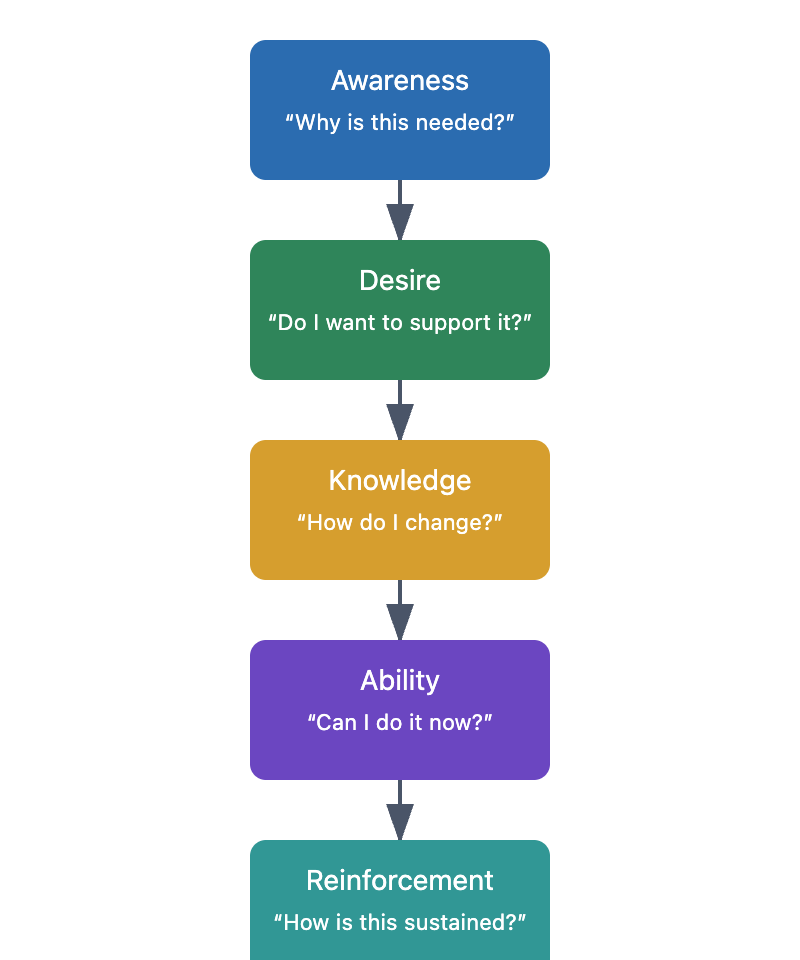As an HR business partner, you are uniquely positioned to bridge the gap between leadership and employees, ensuring that change initiatives are not only implemented but also embraced at every level.In this unit, you’ll focus on how to guide your organization through change, using empathy, strategic foresight, and a collaborative approach. You’ll develop skills to assess organizational readiness for change, communicate clearly with both leaders and employees, and sustain engagement throughout the process.
By practicing these skills, you’ll be equipped to balance the needs of people and operations, and strengthen your role as a trusted advisor to business leaders during times of transition.
Change affects not just processes and systems, but also the emotions and confidence of the people involved. As an HR business partner, your unique position allows you to recognize and address these impacts across the organization. For example, when a new process is introduced, some employees may feel energized, while others may express anxiety or skepticism. You might hear someone say, "I'm worried this new system will make my job harder", which signals a need for empathy and reassurance from HR.
Responding with credibility and care—such as "I understand this feels like a big shift, and we're here to support you through it"—helps build trust and keeps communication open. Your role is to listen, validate concerns, and reinforce the partnership between HR and business leaders, ensuring that both people and operational needs are addressed. As an HR business partner, you are also responsible for helping leaders understand the human side of change, and for advocating for employee well-being while supporting business objectives.
As an HR business partner, it’s your responsibility to gauge how ready your organization is for change and to identify where resistance might surface. Signs of readiness could include active participation in discussions or thoughtful questions during meetings, like "How will this change affect our daily workflow?" On the other hand, resistance might show up as withdrawal or skepticism, such as "We've tried this before and it didn't work."
A helpful tool for HR business partners is the ADKAR framework (Awareness, Desire, Knowledge, Ability, Reinforcement), which provides a structured approach to managing individual and organizational change. You can use ADKAR to assess where employees and leaders are in their change journey:

Anticipating reactions using the ADKAR framework allows you to tailor your approach and advise leaders accordingly. For example, if a team is already stretched thin, you might recommend pacing the rollout or providing extra support. Your strategic suggestions should always balance employee needs with operational goals. If a restructuring is planned, you could propose regular updates, targeted training, and open feedback channels. A well-aligned recommendation might sound like: "Let's hold weekly Q&A sessions so employees can share concerns, and we can clarify how these changes support our business objectives."
By focusing on both the human and operational sides of change, and leveraging frameworks like ADKAR, you’ll help your organization move forward with confidence and resilience, and demonstrate the value of HR as a strategic partner.
Here’s a brief conversation between Jessica, a business leader and Ryan, an HR business partner that demonstrates how to acknowledge emotional reactions with empathy and credibility:
- Jessica: I have to admit, I'm really anxious about this new restructuring. My team is already stretched thin, and I’m worried this will just add more stress.
- Ryan: I hear you, Jessica. It’s completely understandable to feel that way, especially with everything your team is handling right now.
- Jessica: I just don’t want morale to drop or people to feel unsupported.
- Ryan: That’s a valid concern. We’re committed to supporting you and your team through this. Let’s talk about what resources or communication might help ease the transition.
In this exchange, Ryan listens actively, validates Jessica’s concerns, and reinforces HR’s partnership and support. Notice how he avoids dismissing her feelings and instead offers a path forward, which builds trust and credibility. As an HR business partner, these conversations are essential for building the trust needed to guide both leaders and employees through change.
In the next role-play session, you’ll have the chance to practice acknowledging emotional reactions with empathy and credibility—an essential first step in leading partnership-centered change as an HR business partner.
